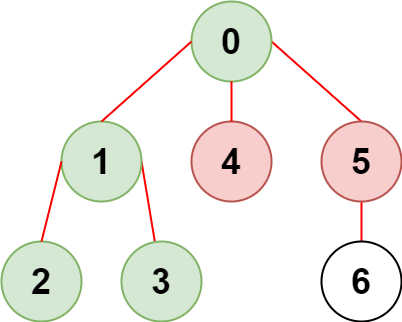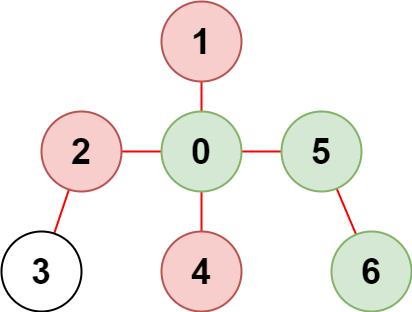| comments | difficulty | edit_url | rating | source | tags | |||||||
|---|---|---|---|---|---|---|---|---|---|---|---|---|
true |
Medium |
1476 |
Weekly Contest 305 Q2 |
|
There is an undirected tree with n nodes labeled from 0 to n - 1 and n - 1 edges.
You are given a 2D integer array edges of length n - 1 where edges[i] = [ai, bi] indicates that there is an edge between nodes ai and bi in the tree. You are also given an integer array restricted which represents restricted nodes.
Return the maximum number of nodes you can reach from node 0 without visiting a restricted node.
Note that node 0 will not be a restricted node.
Example 1:
Input: n = 7, edges = [[0,1],[1,2],[3,1],[4,0],[0,5],[5,6]], restricted = [4,5] Output: 4 Explanation: The diagram above shows the tree. We have that [0,1,2,3] are the only nodes that can be reached from node 0 without visiting a restricted node.
Example 2:
Input: n = 7, edges = [[0,1],[0,2],[0,5],[0,4],[3,2],[6,5]], restricted = [4,2,1] Output: 3 Explanation: The diagram above shows the tree. We have that [0,5,6] are the only nodes that can be reached from node 0 without visiting a restricted node.
Constraints:
2 <= n <= 105edges.length == n - 1edges[i].length == 20 <= ai, bi < nai != biedgesrepresents a valid tree.1 <= restricted.length < n1 <= restricted[i] < n- All the values of
restrictedare unique.
First, we construct an adjacency list
Next, we define a depth-first search function
Finally, we return
The time complexity is
class Solution:
def reachableNodes(
self, n: int, edges: List[List[int]], restricted: List[int]
) -> int:
def dfs(i: int) -> int:
vis.add(i)
return 1 + sum(j not in vis and dfs(j) for j in g[i])
g = defaultdict(list)
for a, b in edges:
g[a].append(b)
g[b].append(a)
vis = set(restricted)
return dfs(0)class Solution {
private List<Integer>[] g;
private boolean[] vis;
public int reachableNodes(int n, int[][] edges, int[] restricted) {
g = new List[n];
vis = new boolean[n];
Arrays.setAll(g, k -> new ArrayList<>());
for (var e : edges) {
int a = e[0], b = e[1];
g[a].add(b);
g[b].add(a);
}
for (int i : restricted) {
vis[i] = true;
}
return dfs(0);
}
private int dfs(int i) {
vis[i] = true;
int ans = 1;
for (int j : g[i]) {
if (!vis[j]) {
ans += dfs(j);
}
}
return ans;
}
}class Solution {
public:
int reachableNodes(int n, vector<vector<int>>& edges, vector<int>& restricted) {
vector<int> g[n];
vector<int> vis(n);
for (auto& e : edges) {
int a = e[0], b = e[1];
g[a].emplace_back(b);
g[b].emplace_back(a);
}
for (int i : restricted) {
vis[i] = true;
}
function<int(int)> dfs = [&](int i) {
vis[i] = true;
int ans = 1;
for (int j : g[i]) {
if (!vis[j]) {
ans += dfs(j);
}
}
return ans;
};
return dfs(0);
}
};func reachableNodes(n int, edges [][]int, restricted []int) int {
g := make([][]int, n)
vis := make([]bool, n)
for _, e := range edges {
a, b := e[0], e[1]
g[a] = append(g[a], b)
g[b] = append(g[b], a)
}
for _, i := range restricted {
vis[i] = true
}
var dfs func(int) int
dfs = func(i int) (ans int) {
vis[i] = true
ans = 1
for _, j := range g[i] {
if !vis[j] {
ans += dfs(j)
}
}
return
}
return dfs(0)
}function reachableNodes(n: number, edges: number[][], restricted: number[]): number {
const vis: boolean[] = Array(n).fill(false);
const g: number[][] = Array.from({ length: n }, () => []);
for (const [a, b] of edges) {
g[a].push(b);
g[b].push(a);
}
for (const i of restricted) {
vis[i] = true;
}
const dfs = (i: number): number => {
vis[i] = true;
let ans = 1;
for (const j of g[i]) {
if (!vis[j]) {
ans += dfs(j);
}
}
return ans;
};
return dfs(0);
}Similar to Solution 1, we first construct an adjacency list
Next, we use breadth-first search to traverse the entire graph and count the number of reachable nodes. We define a queue
After the traversal, we return the answer.
The time complexity is
class Solution:
def reachableNodes(
self, n: int, edges: List[List[int]], restricted: List[int]
) -> int:
g = defaultdict(list)
for a, b in edges:
g[a].append(b)
g[b].append(a)
vis = set(restricted + [0])
q = deque([0])
ans = 0
while q:
i = q.popleft()
ans += 1
for j in g[i]:
if j not in vis:
q.append(j)
vis.add(j)
return ansclass Solution {
public int reachableNodes(int n, int[][] edges, int[] restricted) {
List<Integer>[] g = new List[n];
boolean[] vis = new boolean[n];
Arrays.setAll(g, k -> new ArrayList<>());
for (var e : edges) {
int a = e[0], b = e[1];
g[a].add(b);
g[b].add(a);
}
for (int v : restricted) {
vis[v] = true;
}
Deque<Integer> q = new ArrayDeque<>();
q.offer(0);
int ans = 0;
for (vis[0] = true; !q.isEmpty(); ++ans) {
int i = q.pollFirst();
for (int j : g[i]) {
if (!vis[j]) {
q.offer(j);
vis[j] = true;
}
}
}
return ans;
}
}class Solution {
public:
int reachableNodes(int n, vector<vector<int>>& edges, vector<int>& restricted) {
vector<int> g[n];
vector<int> vis(n);
for (auto& e : edges) {
int a = e[0], b = e[1];
g[a].emplace_back(b);
g[b].emplace_back(a);
}
for (int i : restricted) {
vis[i] = true;
}
queue<int> q{{0}};
int ans = 0;
for (vis[0] = true; !q.empty(); ++ans) {
int i = q.front();
q.pop();
for (int j : g[i]) {
if (!vis[j]) {
vis[j] = true;
q.push(j);
}
}
}
return ans;
}
};func reachableNodes(n int, edges [][]int, restricted []int) (ans int) {
g := make([][]int, n)
vis := make([]bool, n)
for _, e := range edges {
a, b := e[0], e[1]
g[a] = append(g[a], b)
g[b] = append(g[b], a)
}
for _, i := range restricted {
vis[i] = true
}
q := []int{0}
for vis[0] = true; len(q) > 0; ans++ {
i := q[0]
q = q[1:]
for _, j := range g[i] {
if !vis[j] {
vis[j] = true
q = append(q, j)
}
}
}
return
}function reachableNodes(n: number, edges: number[][], restricted: number[]): number {
const vis: boolean[] = Array(n).fill(false);
const g: number[][] = Array.from({ length: n }, () => []);
for (const [a, b] of edges) {
g[a].push(b);
g[b].push(a);
}
for (const i of restricted) {
vis[i] = true;
}
const q: number[] = [0];
let ans = 0;
for (vis[0] = true; q.length; ++ans) {
const i = q.pop()!;
for (const j of g[i]) {
if (!vis[j]) {
vis[j] = true;
q.push(j);
}
}
}
return ans;
}
